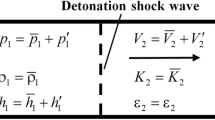Abstract
An experimental study is made of the turbulent boundary layer in its interaction with a shock wave, the purpose being to clarify questions connected with the increase in the fullness of the velocity profiles. New systematic data are obtained on the development of the boundary layer, and its structure and asymptotic behavior beyond the interaction region. These results are for axisymmetric flow in the range of Mach numbers M=2–4 and angles of rotation of the flow 10–25°. Conditions of developed separation are included. Extensive information about the general properties of flows with separation has been obtained in a number of studies. A survey of these may be found, for example, in [1, 2]. Certain questions about the separation and reattachment of the boundary layer are clarified. The dimensions of the separation region are determined and its structure studied in detail for various shapes of the surface around which the flow takes place. Nevertheless it has not yet proved possible to reach a complete understanding of this complex phenomenon. Usually plane models have been used for the investigations, but in this case it is evidently impossible to exclude completely the influence of end effects on the flow in the interaction zone. Therefore it is preferable to study such flows in axisymmetric models; this considerably eases the task of analyzing and interpreting the results.
Similar content being viewed by others
Literature cited
L. V. Gogish and G. Yu. Stepanov, Turbulent Flows with Separation [in Russian], Nauka, Moscow (1979).
M. A. Gol'dfel'd and É. G. Tyutina, Research into a Compressible Axisymmetric Turbulent Boundary Layer in Complex Conditions with Flow Separation [in Russian], Novosibirsk (1983).
G. S. Settles, I. E. Vas, and S. M. Bogdonoff, “Details of a shock-separated turbulent boundary layer of a compression corner,” AIAA J.,14, 1709 (1976).
M. A. Amelina, Yu. I. Vyshenkov, V. S. Dem'yanenko, A. A. Zheltovodov, and V. S. Zuenko, “Research on methods of measuring pressures in a T-313 wind tunnel with automatic input and processing of the data on a computer,” in: Aerophysical Studies. No. 5. Problems of Gas Dynamics [in Russian], Novosibirsk (1975), pp. 287–291.
G. I. Petrov, V. Ya. Likhushin, I. P. Nekrasov, and L. I. Sorkin, “The effect of viscosity on supersonic flow with shock waves,” Tr. TsIAM, No. 224, 28 (1952).
Yu. A. Panov and A. I. Shehvets, “Separation of a turbulent boundary layer in supersonic flow,” in: Applied Mechanics, Vol. 2 [in Russian], Kiev (1966), pp. 99–105.
M. A. Gol'dfel'd and V. N. Dolgov, “The development of a turbulent boundary layer after interaction with a shock wave at Mach numbers 2–6,” Izv. Sib. Otd. Akad. Nauk SSSR, Ser. Tekh. Nauk, No. 3, 9 (1976).
M. A. Gol'dfel'd, “Calculation of parameters of the boundary layer after interaction with a shock wave and a rarefaction wave fan during heat exchange,” in: Aerophysical Studies. No. 6. Physical Gas Dynamics [in Russian], Novosibirsk (1976), pp. 132–137.
H. Schlichting, Boundary Layer Theory, McGraw-Hill, New York (1968).
H. Fernholz, “Geschwindigkeitsprofile, Temperaturprofile und halbempirische Gesetze in kompressiblen turbulenten Grenzschichten bei konstantem Druck,” Ing. Arch.,38, 311 (1969).
M. A. Gol'dfel'd and Yu. A. Saren, “Approximate determination of the surface friction from the velocity profile of a two-dimensional compressible turbulent boundary layer,” in: The Third All-Union School on Methods in Aerophysical Research [in Russian], Novosibirsk (1982), pp. 129–132.
G. S. Settles, T. J. Fitzpatrick, and S. M. Bogdonoff, “Detailed study of attached and separated compression corner flowfields in high Reynolds number supersonic flow,” AIAA J.,17, 579 (1979).
M. A. Gol'dfel'd, “The development of a supersonic turbulent boundary layer after passage across a rarefaction wave fan,” in: Studies in Viscous Gas Flow Next to a Wall [in Russian], Novosibirsk (1979), pp. 103–123.
Author information
Authors and Affiliations
Additional information
Translated from Izvestiya Akademii Nauk SSSR, Mekhanika Zhidkosti i Gaza, No. 5, pp. 75–82, September–October, 1985.
Rights and permissions
About this article
Cite this article
Gol'dfel'd, M.A. The structure of the supersonic turbulent boundary layer in its interaction with a shock wave. Fluid Dyn 20, 728–734 (1985). https://doi.org/10.1007/BF01050086
Received:
Issue Date:
DOI: https://doi.org/10.1007/BF01050086




